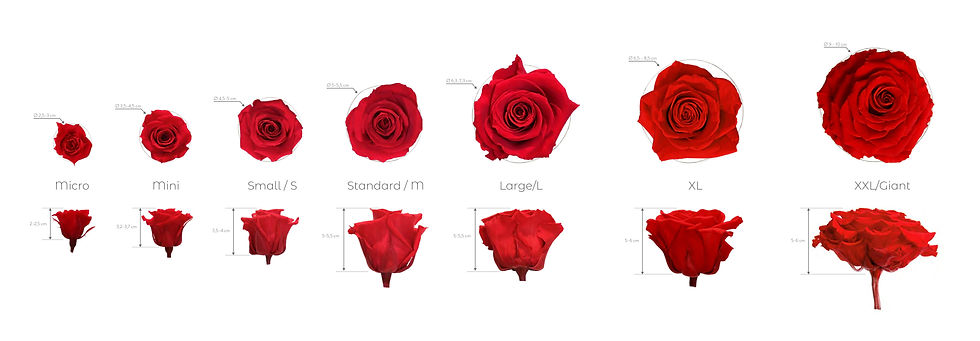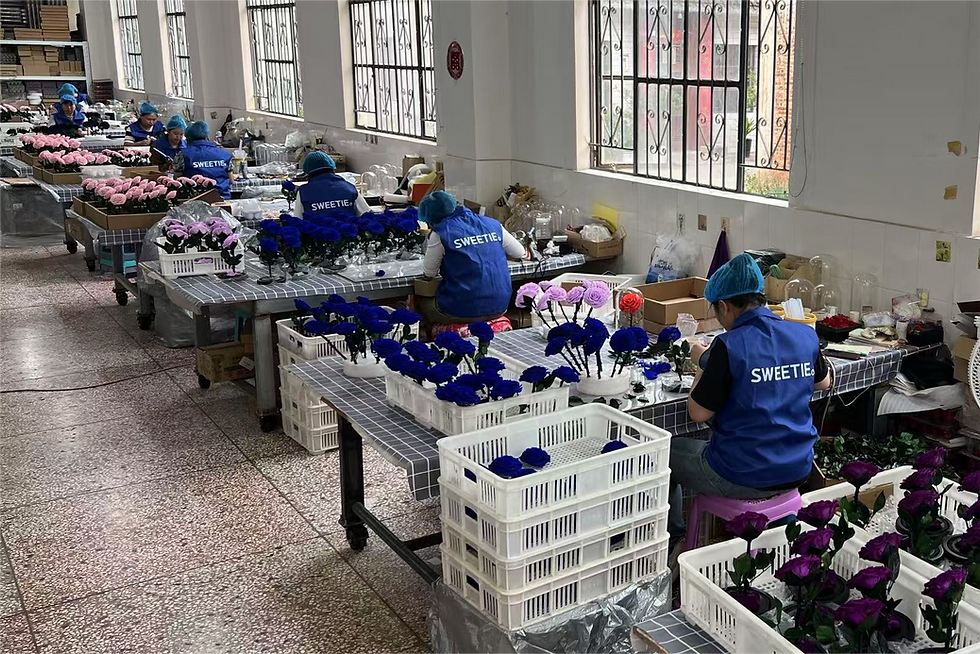Preserved Rose Size Guide: From 2cm Minis to 10cm Giants for Retail & Wholesale Buyers
- Annie Zhang

- Aug 22
- 4 min read

Choosing the right preserved rose size isn’t as simple as “the bigger, the better.” Retail buyers, wholesalers, and product developers often run into the same questions: Which diameter works best for a jewelry box? What size fits a standard dome? How do I balance cost with visual impact?
Get the size wrong, and you might face mismatched packaging, higher breakage rates, or wasted budgets. Get it right, and you’ll see better product photos, happier customers, and smoother supply chain planning. This guide breaks down everything—from tiny 2cm roses to giant 10cm statement pieces—so you can make informed decisions.
Index:
Common Preserved Rose Sizes Explained
Preserved roses are typically measured by their diameter (D) and cup height (H). While different factories may label sizes differently, the ranges are fairly consistent.
Here’s a quick comparison table:
Industry Name | Diameter (D) | Cup Height (H) | Typical Uses |
Micro / XS | 2.5–3.0 cm | 2–2.5 cm | Jewelry, rings, brooches, card decoration |
Mini | 3.0–4.5 cm | 3.2–3.7 cm | DIY kits, letter roses, multi-head gift boxes |
Small / S | 3.5–4.0 cm | 3.5–4.0 cm | E-commerce bestsellers, flexible fit |
Standard / M | 4.5–5.5 cm | 5–5.5 cm | Single-head gift boxes, standard domes |
Large / L | 6.3–7.3 cm | 5–5.5 cm | Hero flowers in center stage |
XL | 6.5–8.5 cm | 5–6 cm | High-end designs, fewer colors available |
XXL / Giant | 9.0–10 cm | 5–6 cm | Window display, luxury branding, exhibitions |
Note: Diameter is measured at the widest point, with a typical tolerance of ±2–3 mm.

Matching Size to Usage Scenarios
Jewelry & AccessoriesFor micro spaces—rings, earrings, hairpins—Micro and Mini roses (1.5–3.5 cm) are your best bet. They’re lightweight, safe for shipping, and easy to mount.
Gift Boxes & Domes
Mini domes (8–10 cm external): Small roses (3–4.5 cm), high cup for fullness.
Standard domes (10–12 cm): Standard/M (4.5–5.5 cm), the most balanced choice.
Large domes (12–14 cm): Large or XL (5.5–7.5 cm), ideal for statement gifts.
Frames & Shadow Boxes
Shallow designs call for low cup roses (3–5 cm) so the lid can close smoothly.
Bouquets & Hat Boxes
Combine multiple S–M roses for coverage and add one L rose in the center to draw the eye. This technique boosts perceived value without overspending.
Event & Branding
For weddings, stages, or window displays, XL and XXL roses shine. Their size holds visual power even from a distance of one meter or more.
How to Select the Right Rose Size: A Three-Step Method
Measure the container’s inner diameter. Subtract 0.5–1 cm to leave breathing room.
Decide on cup height. Go with high cup for domes, low cup for frames.
Match size to purpose and budget. Want luxury impact? Use the largest size that fits. Want balance? Combine one large rose with several smaller ones.
Pro tip: Since surface area grows roughly with diameter², the unit cost of large roses rises faster than their size. A “1 large + several small” combo often looks richer while keeping costs manageable.
👉 If you’re planning your next SKU lineup, email me at sales@sweetie-group.com. I’d be happy to help map out a size and color mix that fits your sales channels.

Retail Buyers vs. Wholesale Buyers: What to Keep in Mind
From the Consumer’s Perspective
Premium gift appeal: M or L roses (4.5–6.5 cm) in domes or gift boxes signal “luxury.”
Budget-friendly options: Mini or S roses offer DIY flexibility and more color combinations.
Practicality: Smaller sizes survive transport better and require less dusting.
From the Wholesale / B2B Perspective
SKU balance:
S–M (3.5–5.5 cm): 60–70% of volume.
L (5.5–6.5 cm): 20–30%, for visual anchors.
XL–XXL: 5–10%, for premium launches.
Quality control: Always confirm tolerance with your factory (±2–3 mm is standard).
Color vs. size availability: Large heads come in fewer shades and may require longer lead times.
Packaging: Bigger roses need stronger bases and protective rings to prevent breakage in shipping.
👉 Need a pre-packed SKU structure optimized for e-commerce or supermarkets? Drop me a line at sales@sweetie-group.com, and I’ll share proven breakdowns we’ve seen succeed in Europe and the U.S.
Quick Container-to-Rose Size Reference
Frame inner diameter 6–8 cm → 3.5–4.5 cm (low cup)
Mini dome 8–10 cm → 3–4.5 cm (high cup)
Standard dome 10–12 cm → 4.5–5.5 cm
Large dome 12–14 cm → 5.5–6.5 cm or 6.5–7.5 cm
Gift box 7–9 cm → 4–5 cm or Mini combo
Hat box 15–20 cm → S–M for base, plus 1 L for center
👉 If you’re unsure which size fits your packaging, just send me the box dimensions at sales@sweetie-group.com. I’ll suggest the closest match and help you avoid costly trial and error.

About Our Preserved Rose Factory
At Sweetie-Gifts, we’ve been making preserved flowers for nearly two decades. Our factories in Kunming, Yiwu, and Beijing give us full control over sourcing, production, and quality inspection. With more than 250 employees, including 27 R&D specialists and 51 professional sales staff, we supply preserved roses to over 50 countries.
We produce preserved rose boxes, domes, bouquets, jewelry boxes, and even custom corporate gifts. Our clients include well-known global brands like Dior, Lancôme, and the British Museum, as well as international retailers like AEON, Walgreens, and Gifi.
Every rose goes through a careful preservation process: dehydration, shaping, coloring, and slow drying. This ensures stable quality and a lifespan of 12 months or more with proper care.
Whether you’re looking for bulk orders, custom packaging, or small-batch OEM trials, we can help streamline your supply chain and keep your SKUs competitive.
Final thought: Choosing preserved rose sizes isn’t about memorizing numbers—it’s about matching the right flower head to your market, container, and brand story. With the right planning, you can avoid costly mismatches and create products that truly resonate with customers.

CEO of Sweetie-Group









Comments